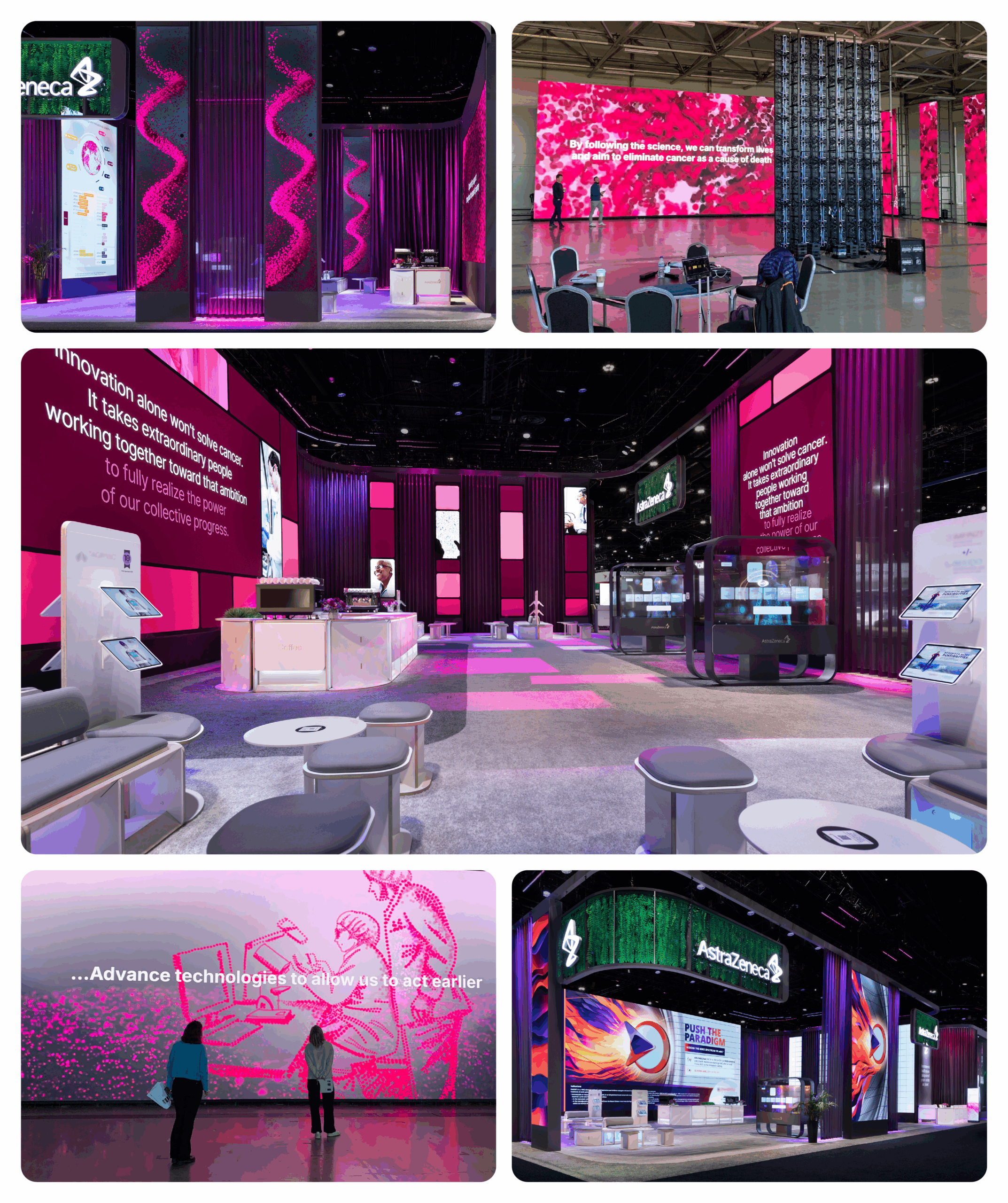Immersive Science. Intelligent Design. Strategic Impact.
At ASCO 2025, we partnered with AstraZeneca to deliver a next-generation booth experience – uniting breakthrough science, audience-first design, and sustainable thinking in one intelligent, immersive platform.
Discover how our in-house exhibitions, creative and digital teams redefined congress engagement.

The Challenge
At a global event where every detail is under scrutiny, AstraZeneca needed a presence that reflected its leadership in oncology – and its commitment to meaningful, measurable engagement.
AstraZeneca’s ambition for ASCO 2025 was clear: create a presence that reflects their global leadership in oncology, drives meaningful healthcare professional (HCP) engagement, and brings their science to life in a way that’s immersive, intelligent, and responsibly built.
Key objectives were to:
- Showcase a unified portfolio across pipeline, trials, and therapies
- Engage HCPs with personalized, interactive experiences that fit their pace
- Reduce environmental impact in line with AstraZeneca’s Net Zero 2045 Ambition
- Move beyond a single-use build with a scalable, global model for reuse
- Deliver a congress experience that was as inspiring as it was strategic
The Solution
The booth was built as an open, immersive environment – designed to be explored, not just observed. A fluid architectural layout used 20 foot high semi-transparent fabric to create flow and openness while accommodating different visitor types: skimmers, paddlers, and deep-divers.
At the heart of the experience was a particle-based ecosystem avatar, which evolved across screens to guide delegates through curated journeys – reinforcing AstraZeneca’s commitment to human-centered oncology leadership.
Towering 20-foot-high LED screens and transparent world-first 77 inch OLED touchscreens surrounded visitors with science and story, enabling immersive interaction and bold visual presence across the show floor. Full-booth takeovers synchronized 23 LED displays, dynamic lighting, and directional sound, enveloping attendees in coordinated audiovisual moments that drew in foot traffic and deepened engagement once inside.

Technology was deeply embedded throughout the experience:
- Apple Vision Pro headsets and RFID blocks for immersive material storytelling
- Touchscreen apps, iPads, and QR tools powered by Emota’s FOYAH content management system
- Delegates could curate personalized content baskets for digital takeaway, eliminating printed materials and enhancing relevance
Built for more than a single moment, the booth was conceived as a modular, scalable toolkit. The layout flexed like a digital interface – optimizing space, maintaining flow, and ensuring consistency across multiple venues. It’s now in use across AstraZeneca’s congress portfolio, supporting over 300 events a year while minimizing waste and maximizing brand impact.
“The booth onsite was truly outstanding – every aspect: design, content, technology, film, digital, coffee, all of it. I received (with no exaggeration) hundreds of remarks on how incredible the booth was. It was called “best of show” and, by some, the best they’d ever seen – feedback coming from AZ staff, competitors, stand builders, creative agencies, associations, and attendees alike. The experience and results last week are something everyone should be deeply proud of.”
– Bobby Pierro, Senior Manager, AstraZeneca Oncology Exhibitions

Sustainability
Sustainability wasn’t backstage – it was center stage.
From concept to construction, we applied a circular mindset using Emota’s Enviroplan methodology. Every decision was driven by impact: reusable, repairable materials; modular design systems; and a visible sustainability narrative on the booth floor.
Key actions and materials included:
- Structural cardboard (67.9% lower CO₂e vs. MDF), FSC-certified and fully recyclable
- Recycled carpets made from plastic bottles, reused across multiple events
- FSC-certified plywood furniture, cutting 50% of fabrication steps and 30% of material use
- Reclaimed PET acoustic panels, recycled paper art, and toxin-free recycled upholstery
- Fabric partitions, reducing material waste and freight emissions by replacing MDF walls
- Tabletops made from 100% recycled plastic, durable and long-lasting
Sustainability was made visible and interactive. A dedicated sustainability area used RFID blocks and Apple Vision Pro to immerse delegates in the materials’ lifecycle stories. Attendees didn’t just learn about sustainability – they experienced it.
Our approach was certified by the BOSS framework:
- 85% overall sustainability score
- “Green” rating on the Carbon Action Indicator
- Recognition for “Potential for Positive Change”, meeting all six global criteria
- Support for 3 UN Sustainable Development Goals
Designed for three years and 300+ events, this is no one-off. Each reuse compounds environmental gains – demonstrating that responsible design can drive both performance and progress.
“The sustainability across the whole event is amazing, and how it was thought out in pre-production, but also how it was brought to life in a story for guests.”
– C&IT Awards – Judges comments
The Value Created
This project proved that success doesn’t require compromise—AstraZeneca achieved its commercial, creative, and sustainability goals through a single, integrated approach.
- 41% of all ASCO delegates engaged, with 18,257 unique visitors and 87% conversion from foot traffic
- 11% returned for repeat visits, with dwell time averaging over 7 minutes
- 50% more LinkedIn mentions than any competitor, including praise as “best of show” by peers, competitors, and associations
- 12% reduction in budget and 25% cut in freight volume, proving sustainability is commercially efficient
- A reusable, scalable toolkit now powering AstraZeneca’s congress presence worldwide
This was more than a booth. It was a bold step toward a future where immersive engagement and environmental intelligence go hand-in-hand – and where meaningful science is matched by meaningful responsibility.